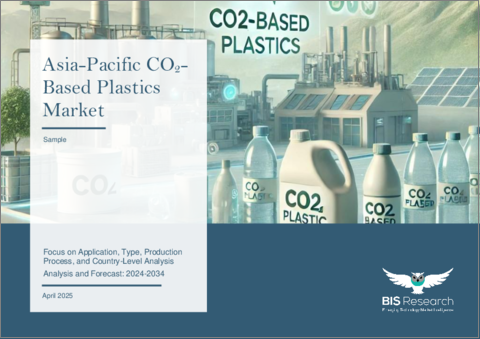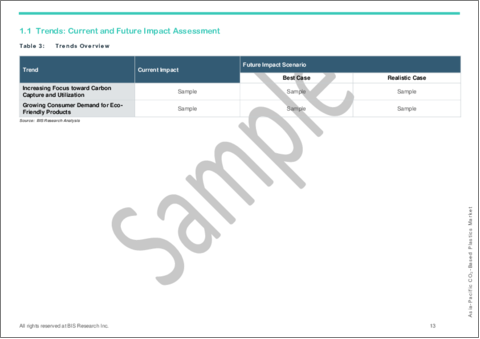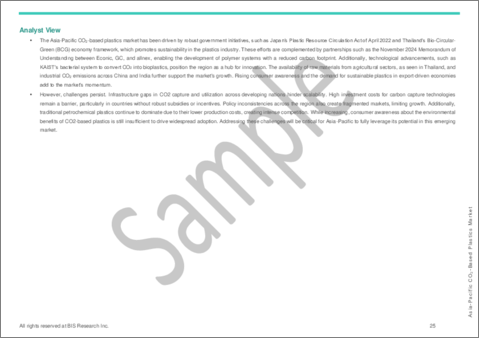|
|
市場調査レポート
商品コード
1700012
アジア太平洋のCO2ベースプラスチック市場:用途別、製品タイプ別、生産プロセス別、国別 - 分析と予測(2024年~2034年)Asia-Pacific CO2-Based Plastics Market: Focus on Application, Type, Production Process, and Country-Level Analysis - Analysis and Forecast, 2024-2034 |
||||||
カスタマイズ可能
|
|||||||
| アジア太平洋のCO2ベースプラスチック市場:用途別、製品タイプ別、生産プロセス別、国別 - 分析と予測(2024年~2034年) |
|
出版日: 2025年04月10日
発行: BIS Research
ページ情報: 英文 69 Pages
納期: 1~5営業日
|
- 全表示
- 概要
- 図表
- 目次
アジア太平洋のCO2ベースプラスチックの市場規模は、2024年の7,490万米ドルから2034年には43億890万米ドルに達し、予測期間の2024年~2034年のCAGRは49.97%になると予測されています。
二酸化炭素排出量の削減と持続可能な材料の確保が重視されるようになり、アジア太平洋の市場力学は劇的に変化しています。具体的には、環境規制の変化と炭素回収・利用(CCU)技術の急速な開発が、プラスチック・ビジネスに変革をもたらしつつあります。アジア太平洋諸国の政府は環境規制を強化し、より効率的でクリーンな生産技術への転換を企業に迫っています。イノベーションを促進し、緊急の環境問題に取り組むセクター横断的なパートナーシップも、こうした取り組みを後押ししています。
CO2ベースのプラスチックは、アジア太平洋ビジネスが高まる規制圧力やより環境に優しい製品を求める消費者需要に対応するため、競争力のある代替品として人気が高まっています。技術の進歩により、低炭素生産はより現実的なものとなりつつあり、それはまた、企業の経営効率を高め、環境への影響を軽減することにも役立っています。この変化は中国、日本、韓国のような市場で特に顕著であり、そこでは国家的な持続可能性アジェンダと官民パートナーシップがグリーン・イノベーションを最優先事項としています。
| 主要市場統計 | |
|---|---|
| 予測期間 | 2024年~2034年 |
| 2024年の評価 | 7,490万米ドル |
| 2034年の予測 | 43億890万米ドル |
| CAGR | 49.97% |
アジア太平洋市場は、産業界の協力、技術革新、法制の後押しにより、持続可能な生産における急速な市場開拓のリーダーとして位置づけられています。循環型経済と低炭素の未来に向けた世界の動向と同様に、この傾向は、この地域が経済拡大と環境責任のバランスを取ることに専念していることを再確認するものです。
アジア太平洋におけるCO2ベースのプラスチック市場は、より環境に優しく持続可能な生産方法への移行に伴い拡大しています。プラスチック汚染、二酸化炭素排出、気候変動に対する懸念が高まる中、アジア太平洋地域の産業界は、石油から作られる従来のプラスチックに代わる創造的な代替品に注目しています。CO2ベースのポリマーは、回収した二酸化炭素を原料として使用し、温室効果ガスの排出を抑え、循環型経済の目標を推進するものです。
中国、日本、韓国、インドを含む主要国の政府は、より厳しい環境法を施行し、低炭素技術の創出と導入にインセンティブを与えています。CO2ベースポリマーの開発は、こうした規制の取り組みや、炭素回収・利用(CCU)技術への投資の増加によって助けられています。さらに、消費者製品、自動車、パッケージングなどの業界からの需要の高まりも、市場の可能性を高めています。
官民パートナーシップ、研究プロジェクト、業界連携が技術革新を後押しし、地域全体の生産拡大を支援しています。高い製造コストや不十分なインフラといった障害は依然として残っているもの、継続的な技術革新とそれを支える法的枠組みにより、大きな成長が見込まれています。CO2ベースのプラスチックは、アジア太平洋が気候変動への対応に努めながら工業化を続ける中で、同地域の持続可能な材料転換の重要な要素になると考えられています。
持続可能な素材に対する需要の増加、産業界の脱炭素化への取り組み、環境への関心の高まりが、アジア太平洋のCO2ベースプラスチック市場の成長を促進しています。この地域、特に中国、日本、韓国、インドでは、政府がより厳しい排出規制を施行し、クリーン技術プログラムを推進しているため、産業界は化石燃料由来の従来のプラスチックに代わるものを模索しています。炭素の回収と利用(CCU)の技術開発により、CO2を有益なポリマーに変換することが可能になっており、これはアジア太平洋の持続可能性と循環型経済の目標に沿ったものです。消費者主導の持続可能性目標や規制要件を満たすため、包装、消費財、自動車などの産業がCO2ベースのプラスチックを採用し始めています。
しかし、市場は大きな障害に直面しています。CCUのインフラが未熟で、特殊な加工設備が必要なため、製造コストが高く、より広い範囲での使用が制限されています。生産能力は、多くのアジア太平洋諸国における貧弱な物流と回収されたCO2の利用可能性によって制限されています。さらに、安価な従来のプラスチックとの競合や、CO2ベースの代替品に関する知識不足も障害となっています。しかし、アジア太平洋市場は徐々に発展し、グリーン技術への投資の増加、研究活動の拡大、官民パートナーシップの開拓の結果、低炭素で気候変動に強い材料への世界の移行において重要な役割を果たすと予想されます。
自動車、包装、建築、消費財など、産業界におけるCO2ベースのプラスチックの多様な用途を調査しています。熱触媒、光触媒、電気化学変換などの製造技術の進歩や、炭素回収、ポリマー合成の革新に焦点を当てています。また、ポリウレタン、ポリカーボネート、その他のCO2由来ポリマーなどの主要素材と、高度な触媒や自動化ツールなどの必須技術についても検証しています。ISOやASTMのような組織による規格への業界の準拠については、運用と規制の枠組みを包括的に理解するために議論されています。アジア太平洋のCO2ベースのプラスチック市場は、持続可能な材料への投資の増加、カーボンニュートラルの推進、拡張性と効率を高める技術革新に牽引され、急成長を遂げようとしています。その結果、この市場は持続可能性と収益性を重視した、将来性の高いビジネスモデルとなります。
アジア太平洋のCO2ベースプラスチック市場は、既存参入企業にも新規参入者にも大きな機会を提供しています。主な成長戦略には、M&A、戦略的提携、新製品の発売、地理的拡大などがあります。企業は競争上の優位性を得るため、持続可能な素材と革新的な生産技術の開発を優先しています。カーボンフットプリントを削減し、世界の脱炭素化目標に沿うことに重点を置くことで、市場の拡大がさらに加速しています。
競合戦略では、ポリマーメーカー、技術プロバイダー、インテグレーターなど、アジア太平洋のCO2ベースプラスチック市場における主要参入企業を紹介しています。戦略的パートナーシップ、協定、技術協力を網羅した詳細な競合情勢分析は、利害関係者が未開拓の収益機会を特定するのに役立ちます。この分析は、市場参入企業が技術革新、戦略的提携、持続可能性への注力を通じて自社の地位を高めることを支援するものです。
当レポートでは、アジア太平洋のCO2ベースプラスチック市場について調査し、市場の概要とともに、用途別、製品タイプ別、生産プロセス別、国別の動向、および市場に参入する企業のプロファイルなどを提供しています。
目次
エグゼクティブサマリー
第1章 市場
- 動向:現状と将来への影響評価
- サプライチェーンの概要
- バリューチェーン分析
- 価格予測
- ステークホルダー分析
- 使用事例
- エンドユーザーと購入基準
- 市場力学:概要
- 市場促進要因
- 市場抑制要因
- 市場機会
第2章 地域
- 地域サマリー
- アジア太平洋
- 地域概要
- 市場成長促進要因
- 市場成長抑制要因
- 用途
- 製品
- アジア太平洋(国別)
第3章 市場-競合ベンチマーキングと企業プロファイル
- 今後の見通し
- 地理的評価
- Asahi Kasei Corporation
- ChangHua Chemical Technology Co.,Ltd.
- Cardia Bioplastics
第4章 調査手法
List of Figures
- Figure 1: Asia-Pacific CO2-Based Plastics Market (by Scenario), $Billion, 2024, 2028, and 2034
- Figure 2: Asia-Pacific CO2-Based Plastics Market (by Application), $Million, 2023, 2027, and 2034
- Figure 3: Asia-Pacific CO2-Based Plastics Market (by Type), $Million, 2023, 2027, and 2034
- Figure 4: Asia-Pacific CO2-Based Plastics Market (by Production Process), $Million, 2023, 2027, and 2034
- Figure 5: Competitive Landscape Snapshot
- Figure 6: Key Events
- Figure 7: Annual CO2 Emissions, Billion Tons, 2020-2023
- Figure 8: Percentage of Consumer Behavior toward Sustainability, 2022
- Figure 9: Supply Chain and Risks within the Supply Chain
- Figure 10: Value Chain Analysis
- Figure 11: Impact Analysis of Market Navigating Factors, 2023-2034
- Figure 12: Production Capacities of Bio-Based Polymers per Region, 2023
- Figure 13: Share of Produced Biopolymers in Different Market Segments, 2023
- Figure 14: China CO2-Based Plastics Market, $Million, 2023-2034
- Figure 15: Japan CO2-Based Plastics Market, $Million, 2023-2034
- Figure 16: India CO2-Based Plastics Market, $Million, 2023-2034
- Figure 17: South Korea CO2-Based Plastics Market, $Million, 2023-2034
- Figure 18: Rest-of-Asia-Pacific CO2-Based Plastics Market, $Million, 2023-2034
- Figure 19: Strategic Initiatives (by Company), 2020-2024
- Figure 20: Share of Strategic Initiatives, January 2021-November 2024
- Figure 21: Data Triangulation
- Figure 22: Top-Down and Bottom-Up Approach
- Figure 23: Assumptions and Limitations
List of Tables
- Table 1: Market Snapshot
- Table 2: Opportunities across Region
- Table 3: Trends Overview
- Table 4: CO2-Based Plastics Market Pricing Forecast (by Region), $/kg, 2023-2034
- Table 5: CO2-Based Plastics Market (by Region), $Million, 2023-2034
- Table 6: Asia-Pacific CO2-Based Plastics Market (by Application), $Million, 2023-2034
- Table 7: Asia-Pacific CO2-Based Plastics Market (by Type), $Million, 2023-2034
- Table 8: Asia-Pacific CO2-Based Plastics Market (by Production Process), $Million, 2023-2034
- Table 9: China CO2-Based Plastics Market (by Application), $Million, 2023-2034
- Table 10: China CO2-Based Plastics Market (by Type), $Million, 2023-2034
- Table 11: China CO2-Based Plastics Market (by Production Process), $Million, 2023-2034
- Table 12: Japan CO2-Based Plastics Market (by Application), $Million, 2023-2034
- Table 13: Japan CO2-Based Plastics Market (by Type), $Million, 2023-2034
- Table 14: Japan CO2-Based Plastics Market (by Production Process), $Million, 2023-2034
- Table 15: India CO2-Based Plastics Market (by Application), $Million, 2023-2034
- Table 16: India CO2-Based Plastics Market (by Type), $Million, 2023-2034
- Table 17: India CO2-Based Plastics Market (by Production Process), $Million, 2023-2034
- Table 18: South Korea CO2-Based Plastics Market (by Application), $Million, 2023-2034
- Table 19: South Korea CO2-Based Plastics Market (by Type), $Million, 2023-2034
- Table 20: South Korea CO2-Based Plastics Market (by Production Process), $Million, 2023-2034
- Table 21: Rest-of-Asia-Pacific CO2-Based Plastics Market (by Application), $Million, 2023-2034
- Table 22: Rest-of-Asia-Pacific CO2-Based Plastics Market (by Type), $Million, 2023-2034
- Table 23: Rest-of-Asia-Pacific CO2-Based Plastics Market (by Production Process), $Million, 2023-2034
- Table 24: Market Share
Introduction to Asia-Pacific CO2-Based Plastics Market
The Asia-Pacific CO2-based plastics market is projected to reach $4,308.9 million by 2034 from $74.9 million in 2024, growing at a CAGR of 49.97% during the forecast period 2024-2034. The increasing emphasis on reducing carbon emissions and securing sustainable materials is drastically changing market dynamics in the Asia-Pacific (APAC) region. Specifically, changing environmental rules and the quick development of carbon capture and utilisation (CCU) technology are transforming the plastics business. APAC governments are enforcing stricter environmental regulations and pressuring businesses to switch to more efficient and clean production techniques. Cross-sector partnerships that promote innovation and tackle urgent environmental issues also help these initiatives.
CO2-based plastics are becoming more popular as a competitive substitute as APAC businesses react to mounting regulatory pressure and consumer demand for greener products. Low-carbon production is becoming more practical thanks to technological advancements, which also help businesses increase operational effectiveness and lessen their environmental impact. This change is especially noticeable in markets like China, Japan, and South Korea, where national sustainability agendas and public-private partnerships are giving green innovation top priority.
| KEY MARKET STATISTICS | |
|---|---|
| Forecast Period | 2024 - 2034 |
| 2024 Evaluation | $74.9 Million |
| 2034 Forecast | $4,308.9 Million |
| CAGR | 49.97% |
The APAC market is positioned as a rapidly developing leader in sustainable production thanks to the combination of industry collaboration, technical innovation, and legislative backing. In line with worldwide trends towards a circular economy and a low-carbon future, this trend reaffirms the region's dedication to striking a balance between economic expansion and environmental responsibility.
Market Introduction
The market for CO2-based plastics in Asia-Pacific (APAC) is expanding as the area moves towards more ecologically friendly and sustainable production methods. As worries about plastic pollution, carbon emissions, and climate change increase, industries around Asia-Pacific are looking at creative substitutes for conventional plastics made from petroleum. A promising alternative is provided by CO2-based polymers, which employ collected carbon dioxide as a feedstock to lower greenhouse gas emissions and promote the objectives of the circular economy.
Governments in important nations including China, Japan, South Korea, and India are enforcing more stringent environmental laws and providing incentives for the creation and uptake of low-carbon technologies. The development of CO2-based polymers is being aided by these regulatory initiatives as well as rising investments in carbon capture and utilisation (CCU) technologies. Additionally, growing demand from industries including consumer products, automotive, and packaging is increasing market potential.
Public-private partnerships, research projects, and industry collaborations are boosting innovation and assisting in the expansion of production throughout the region. Significant growth is anticipated because to continued innovations and supporting legislative frameworks, even though obstacles like high manufacturing costs and inadequate infrastructure still persist. CO2-based plastics are positioned to be a key component of the region's sustainable material transition as APAC continues to industrialise while striving to meet climate commitments.
Market Segmentation:
Segmentation 1: by Application
- Packaging
- Films
- Bottles
- Containers
- Trays
- Automotive Components
- Interior Components
- Structural Parts
- Construction Materials
- Pipes
- Panels
- Insulation
- Electronics Components
- Casings
- Connectors
- Circuit Boards
- Textile Processing
- Fibers
- Non-Woven Fabrics
- Others
Segmentation 2: by Type
- Polycarbonates
- Polyurethanes
- Polypropylene Carbonate (PPC)
- Polyethylene Carbonate (PEC)
- Polyethylene Terephthalate (PET)
- Others
Segmentation 3: by Production Process
- Electrochemistry
- Microbial Synthesis
- Thermocatalysis
Segmentation 4: by Region
- Asia-Pacific: China, Japan, India, South Korea, and Rest-of-Asia-Pacific
Market trends, drivers and challenges of APAC CO2-Based Plastics Market
Increased demand for sustainable materials, industrial decarbonisation initiatives, and growing environmental concerns are driving the growth of the Asia-Pacific (APAC) CO2-based plastics market. Industries are looking at alternatives to conventional plastics derived from fossil fuels as a result of governments around the region, especially in China, Japan, South Korea, and India, enforcing stricter emission laws and promoting clean technology programs. Technological developments in carbon capture and utilisation (CCU) are making it possible to transform CO2 into beneficial polymers, which is in line with APAC's objectives for sustainability and the circular economy. In order to satisfy consumer-driven sustainability goals and regulatory requirements, industries like packaging, consumer goods, and automotive are starting to include CO2-based plastics.
However, the market confronts significant obstacles. Wider use is restricted by high manufacturing costs brought on by the infancy of CCU infrastructure and the requirement for specialised processing equipment. Production capacity is limited by the poor logistics and availability of captured CO2 in many APAC nations. Further obstacles include competition from inexpensive conventional plastics and a lack of knowledge about CO2-based substitutes. However, the APAC market is anticipated to develop gradually and play a significant role in the worldwide transition to low-carbon, climate-resilient materials as a result of rising investments in green technology, expanding research activities, and developing public-private partnerships.
How This Report Can Add Value to End Users
Product/Innovation Strategy: This segment explores the diverse applications of CO2-based plastics across industries, including automotive, packaging, construction, and consumer goods. It highlights advancements in production techniques such as thermocatalysis, photocatalysis, and electrochemical conversion, as well as carbon capture and polymer synthesis innovations. The report also examines key materials such as polyurethanes, polycarbonates, and other CO2-derived polymers alongside essential technologies such as advanced catalysts and automation tools. Industry compliance with standards from organizations such as ISO and ASTM are discussed to provide a comprehensive understanding of operational and regulatory frameworks. The APAC CO2-based plastics market is set for rapid growth, driven by increasing investments in sustainable materials, the push for carbon neutrality, and technological innovations that enhance scalability and efficiency. Consequently, this market represents a high-potential business model emphasizing sustainability and profitability.
Growth/Marketing Strategy: The APAC CO2-based plastics market offers substantial opportunities for established players and new entrants. Key growth strategies include mergers and acquisitions, strategic collaborations, new product launches, and geographic expansion. Companies have been prioritizing the development of sustainable materials and innovative production technologies to gain a competitive advantage. The focus on reducing carbon footprints and aligning with global decarbonization goals has been further accelerating market expansion.
Competitive Strategy: The report profiles major players in the APAC CO2-based plastics market, including polymer manufacturers, technology providers, and integrators. A detailed competitive landscape analysis covering strategic partnerships, agreements, and technological collaborations is provided to help stakeholders identify untapped revenue opportunities. This analysis supports market participants in enhancing their position through innovation, strategic alliances, and a focus on sustainability.
Key Market Players and Competition Synopsis
The companies that are profiled in the Asia-Pacific CO2-based plastics market have been selected based on inputs gathered from primary experts and analyzing company coverage, product portfolio, and market penetration.
Some of the prominent names in the CO2-based plastics market are:
- Asahi Kasei Corporation
- ChangHua Chemical Technology Co., Ltd.
- Cardia Bioplastics
Table of Contents
Executive Summary
Scope and Definition
1 Markets
- 1.1 Trends: Current and Future Impact Assessment
- 1.1.1 Increasing Focus toward Carbon Capture and Utilization (CCU)
- 1.1.2 Growing Consumer Demand for Eco-Friendly Products
- 1.2 Supply Chain Overview
- 1.2.1 Value Chain Analysis
- 1.2.2 Pricing Forecast
- 1.3 Stakeholder Analysis
- 1.3.1 Use Case
- 1.3.2 End User and Buying Criteria
- 1.4 Market Dynamics: Overview
- 1.4.1 Market Drivers
- 1.4.1.1 Advancements in Bio-Based Polymers
- 1.4.1.2 Accelerating the Shift toward Renewable Carbon Sources
- 1.4.2 Market Restraints
- 1.4.2.1 Competition and Synergies with Bioplastics
- 1.4.2.2 Fossil-Fuel Plastic Price Fluctuations
- 1.4.3 Market Opportunities
- 1.4.3.1 Customizable Properties for Niche Applications
- 1.4.3.2 Biodegradable Applications of CO2-Based Plastics in Medical Devices and Packaging
- 1.4.1 Market Drivers
2 Regions
- 2.1 Regional Summary
- 2.2 Asia-Pacific
- 2.2.1 Regional Overview
- 2.2.2 Driving Factors for Market Growth
- 2.2.3 Factors Challenging the Market
- 2.2.4 Application
- 2.2.5 Product
- 2.2.6 Asia-Pacific (by Country)
- 2.2.6.1 China
- 2.2.6.2 Japan
- 2.2.6.3 India
- 2.2.6.4 South Korea
- 2.2.6.5 Rest-of-Asia-Pacific
3 Markets - Competitive Benchmarking & Company Profiles
- 3.1 Next Frontiers
- 3.2 Geographic Assessment
- 3.2.1 Asahi Kasei Corporation
- 3.2.1.1 Overview
- 3.2.1.2 Top Products/Product Portfolio
- 3.2.1.3 Top Competitors
- 3.2.1.4 Target Customers/End Users
- 3.2.1.5 Key Personnel
- 3.2.1.6 Analyst View
- 3.2.1.7 Market Share, 2023
- 3.2.2 ChangHua Chemical Technology Co.,Ltd.
- 3.2.2.1 Overview
- 3.2.2.2 Top Products/Product Portfolio
- 3.2.2.3 Top Competitors
- 3.2.2.4 Target Customers/End Users
- 3.2.2.5 Key Personnel
- 3.2.2.6 Analyst View
- 3.2.2.7 Market Share, 2023
- 3.2.3 Cardia Bioplastics
- 3.2.3.1 Overview
- 3.2.3.2 Top Products/Product Portfolio
- 3.2.3.3 Top Competitors
- 3.2.3.4 Target Customers/End Users
- 3.2.3.5 Key Personnel
- 3.2.3.6 Analyst View
- 3.2.3.7 Market Share, 2023
- 3.2.1 Asahi Kasei Corporation
4 Research Methodology
- 4.1 Data Sources
- 4.1.1 Primary Data Sources
- 4.1.2 Secondary Data Sources
- 4.1.3 Data Triangulation
- 4.2 Market Estimation and Forecast






